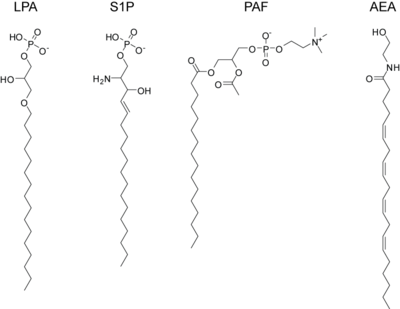Our website is made possible by displaying online advertisements to our visitors.
Please consider supporting us by disabling your ad blocker.
Lipid signaling

lysophosphatidic acid (LPA)
sphingosine-1-phosphate (S1P)
platelet activating factor (PAF)
anandamide or arachidonoyl ethanolamine (AEA)
Lipid signaling, broadly defined, refers to any biological cell signaling event involving a lipid messenger that binds a protein target, such as a receptor, kinase or phosphatase, which in turn mediate the effects of these lipids on specific cellular responses. Lipid signaling is thought to be qualitatively different from other classical signaling paradigms (such as monoamine neurotransmission) because lipids can freely diffuse through membranes (see osmosis). One consequence of this is that lipid messengers cannot be stored in vesicles prior to release and so are often biosynthesized "on demand" at their intended site of action. As such, many lipid signaling molecules cannot circulate freely in solution but, rather, exist bound to special carrier proteins in serum.
Previous Page Next Page


